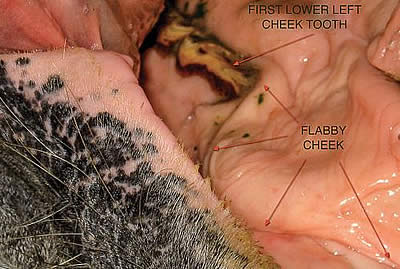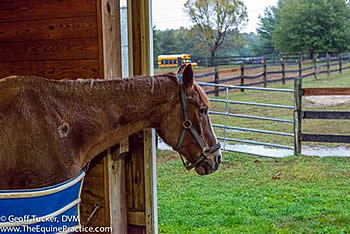We are developing a school for the Tucker Technique of Equine Dentistry. This is the style of dentistry that many of you know about from seeing Melissa and I work on your horses. I feel that this is in the best interest of horses and should be the standard for equine dentistry.
There are no schools teaching this style. All the equine dentistry schools and veterinary schools are teaching the automatic drugging (and over-drugging) of horses, jacking open their mouths, and suspending their heads either on a head stand or from a sling anchored to the ceiling. None of this is in the best interest of the horse. Yet they all say that the result of what they do benefits the horse.
Does the end justify the means?
Our style of connecting with the horse, listening to them, seeking out where the teeth are bothering them, and working on the teeth of a willing and cooperative partner, is an effective approach that is in the best interest of the horse. The results are as good, or even better, as any of those using the other approach promoted by the others – and better for the horse too.
I am promoting to the world the Tucker Technique of Equine Dentistry through a school I am developing and I need your help doing it.
Would you help this project by making a 30 to 60 second video testimonial? In the video, please answer these 3 questions:
- How is our style of equine dentistry different from your past experiences of dentistry with your horse(s)?
- How did your horse respond to our approach and method?
- Why should the Tucker Technique of Equine Dentistry be the standard for dental care of horses in the future?
Just grab your iPhone or Droid or Windows phone and press video. PLEASE HOLD THE PHONE SIDEWAYS (HORIZONTALLY or LANDSCAPE).
Be natural in your delivery (maybe a glass of wine will help!) and remember, there is no “Right” or “Correct” answer or response.
We are trying to tell the world, with all YOUR color, flavor, and character, why the Tucker Technique of Equine Dentistry is better for the horse AND is a very effective way to remove pain and correct eating and bridling problems in your horse.
When done, email the video to me at contact@dentistry.theequinepractice.com.
I am also willing to video you when I am at your barn. But if you are camera shy, just take some notes, write a script, ask your friend to hold the camera, and take and re-take the video until you are comfortable.
I want to thank all of you who believe in the Tucker Technique of Equine Dentistry. It is in the best interest of the horse and more people need to know about it. More people need to learn how to do it. It needs to become the standard of care for equine dentistry.
Please be advised that if you send me a video testimonial, you are giving me permission to use it (along with your name) publicly on the internet. Further, there is no compensation for your efforts. You are just helping us spread the word to the far reaches of the world.
Melissa and I are so grateful for your time on this.



 Every Memorial Day we honor the men and women sacrificing their lives for our freedom. I am humbled by their duty and unselfishness.
Every Memorial Day we honor the men and women sacrificing their lives for our freedom. I am humbled by their duty and unselfishness. It is almost impossible to imagine that these large muscular creatures we call horses get most of their energy from sugar. In my neck of the woods, I have not seen protein shakes for horses nor chicken tenders, though one of my clients does feed his horse chicken nuggets on occasion.
It is almost impossible to imagine that these large muscular creatures we call horses get most of their energy from sugar. In my neck of the woods, I have not seen protein shakes for horses nor chicken tenders, though one of my clients does feed his horse chicken nuggets on occasion.